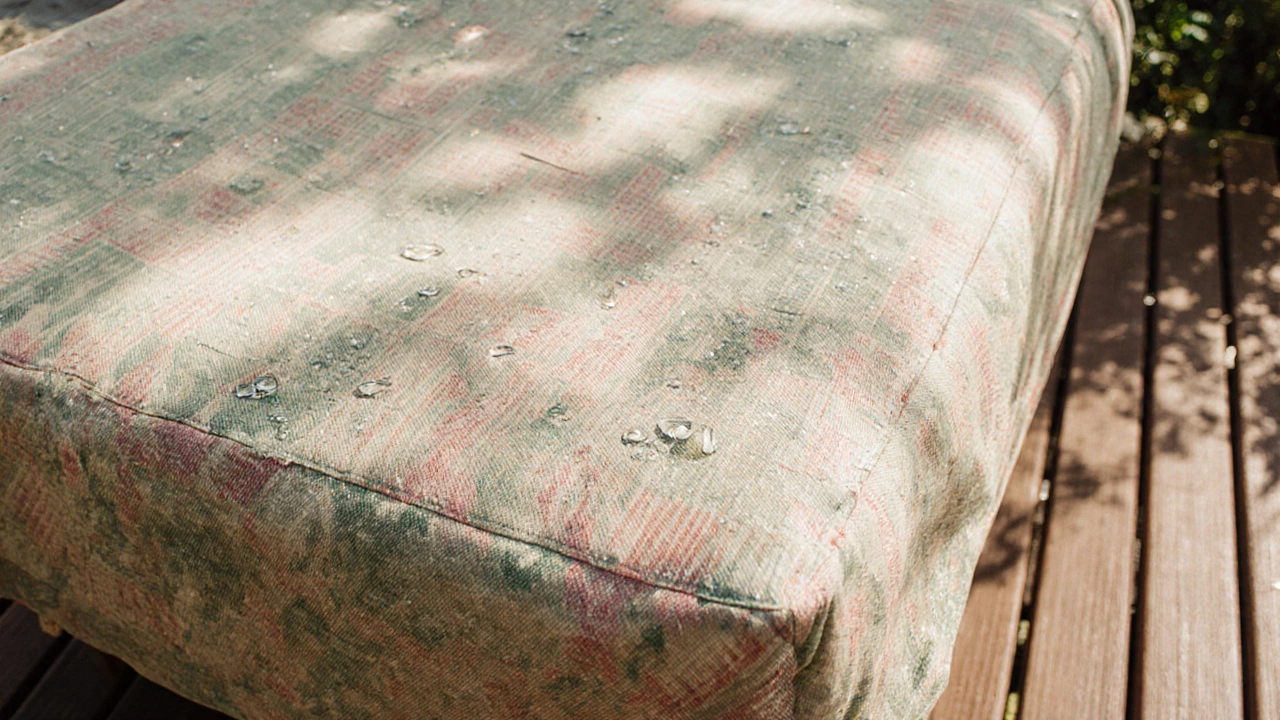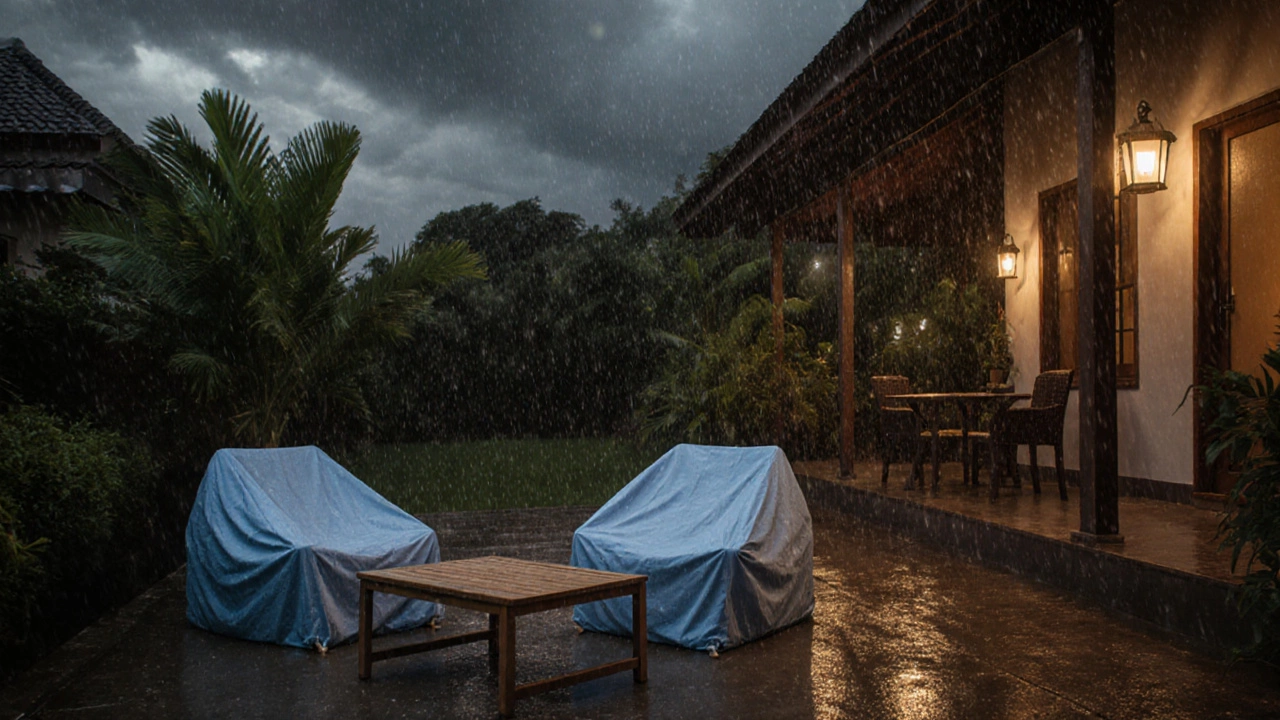Patio Furniture Covering Advisor
Answer these questions to get personalized advice:
Every time you step onto the patio you glance at the lounge set, the table, maybe a swing. It looks inviting, but the next morning a drizzle or a burst of sunshine can change its condition in minutes. The question most homeowners ask is simple: should you cover patio furniture every night? The answer depends on weather, material, and how much effort you’re willing to invest. Below you’ll find a quick rundown, the science behind the wear, and a step‑by‑step plan that lets you protect your outdoor oasis without turning it into a storage room.
Quick Take
- Covering nightly shields most materials from rain, UV damage and wind‑blown debris.
- Use a breathable, waterproof cover; a non‑breathable one can trap moisture and cause mold.
- If you have a storage shed or garage, moving pieces inside during harsh seasons gives the longest lifespan.
- Regular cleaning and a light coat of protectant oil (for wood) or rust inhibitor (for metal) boost any covering strategy.
- Invest in fitted covers that stay snug; loose tarps can swing in the wind and scratch surfaces.
Why Weather Matters
Rain is the most obvious threat. Even light showers seep into seams, wood joints and fabric cushions, causing swelling, rot or mildew. UV rays break down pigments in fabrics and fade finishes on metal or wood. Over a season, unchecked exposure can weaken frames and make cushions feel brittle. Wind can whisk debris-leaves, twigs, sand-against surfaces, acting like sandpaper. Finally, humidity keeps moisture in the air, which encourages mold and rust on metal components. Ignoring these elements shortens the life of a set by years.
Common Patio Furniture Materials and Their Weak Points
Knowing what your set is made of helps you decide how aggressively to protect it.
- Aluminum frames - lightweight, rust‑resistant, but can dent under strong wind.
- Teak or other hardwoods - naturally oily, yet can crack if water sits for weeks.
- Synthetic wicker (resin) - mimics rattan, but UV can cause brittleness over time.
- Steel frames - strong but prone to surface rust if not coated.
- Plastic or polyethylene - cheap, but can fade and become brittle under intense sun.
Each material benefits from a covering strategy tailored to its most vulnerable spot.
Benefits of a Nightly Cover
A dedicated patio furniture cover creates a barrier that blocks water, UV, and wind‑borne grit. The advantages are tangible:
- Extended lifespan - manufacturers estimate up to 30% more years of service when covered.
- Cost savings - avoid replacing cushions or frames early; a $30‑$60 cover pays for itself within a season.
- Consistent aesthetics - colours stay bright, wood retains its golden hue.
- Reduced maintenance - less frequent deep‑cleaning, fewer rust treatments.
For most suburban homes, a nightly routine takes less than two minutes once you have the right gear.
Potential Drawbacks of Covering
Covering isn’t a silver bullet. If you choose the wrong type, you could create new problems.
- Trapped moisture - A non‑breathable tarp can hold condensation, especially on cooler nights. That moisture feeds mold on cushions and rots wood joints.
- Scratches from loose fabric - A cover that flutters can rub against delicate wicker or synthetic fibers, leaving tiny abrasions.
- Cover wear - Cheap polyethylene covers may crack after a few seasons, offering less protection than before.
Choosing a breathable, waterproof material eliminates most of these issues.

Alternatives to Nightly Covering
If you have extra space, consider these options:
- Storage shed - Moving the entire set inside during winter or rainy months eliminates exposure altogether. A small garden shed costs around $800‑$1,200 in Australia and can store a full patio set.
- Garage or patio enclosure - Many homes already have a garage; a simple pallet shelf lets you keep items off the ground and shielded.
- Large umbrella - Provides shade and some rain protection, but wind can lift it, so it’s best for breezy‑free zones.
When storage isn’t an option, a quality cover remains the most practical defense.
Choosing the Right Cover
Look for three key attributes:
- Waterproof yet breathable - Materials like PVC‑coated polyester with micro‑vent holes let air circulate while keeping water out.
- Snug fit - Covers that have elastic hems, drawstrings, or built‑in straps stay in place during gusts.
- UV‑stable coating - Prevents the cover itself from degrading under the sun.
For wooden sets, a breathable cover paired with a light coat of teak oil (or a similar protectant) offers the best protection.
Step‑by‑Step: How to Cover Your Patio Furniture Properly
- Clean first - Remove leaves, wipe down frames, and let everything dry completely. Moisture under a cover is the main cause of mold.
- Apply protectant (optional) - For wood, a thin layer of oil penetrates the grain; for metal, a rust inhibitor spray adds a barrier.
- Lay the cover - Position it so the main opening aligns with the largest piece (usually a table).
- Secure straps - Pull elastic cords or tie drawstrings tightly. Some covers have snap‑on buckles for extra hold.
- Check ventilation - Make sure any vent panels aren’t blocked by cushions.
- Morning check - When you uncover, quickly glance for water pooling or debris. A quick shake‑off prevents long‑term damage.
Doing this routine each evening adds roughly 90 seconds to your night, but the payoff is lasting beauty.
Comparison: Nightly Cover vs. Indoor Storage vs. No Protection
| Strategy | Cost (Initial) | Yearly Maintenance | Protection Level | Convenience |
|---|---|---|---|---|
| Nightly Cover | $30‑$70 | Occasional cover cleaning | High (rain, UV, wind) | Medium (2‑3 min nightly) |
| Indoor Storage (shed/garage) | $800‑$1,200 (shed) or existing garage | Minimal | Very High (no exposure) | Low (move set twice a year) |
| No Protection | None | Frequent cleaning, rust treatment | Low | High (no extra steps) |
Most homeowners fall into the nightly‑cover category because it balances cost and effort. If you’re on a budget but have a spare shed, upgrading to indoor storage yields the greatest lifespan boost.
Maintenance Tips to Keep Your Set in Top Shape
- Seasonal deep clean - At the start of spring, scrub frames with mild soap, rinse, and let dry before covering.
- Reapply protectant - Wood oil every 6‑8 months; metal rust inhibitor annually.
- Inspect covers - Look for tears, UV‑yellowing, or cracked seams. Replace when needed.
- Rotate cushions - Flip and rotate every few weeks to avoid uneven fading.
- Check fasteners - Tighten bolts or screws that may loosen after wind exposure.
These small habits prevent the slow decay that many people mistake for unavoidable “outdoor wear”.
Frequently Asked Questions
Do I need a cover in a dry climate?
Even in arid regions, UV radiation is intense and wind can carry sand that scratches surfaces. A breathable cover guards against sun bleaching and sand abrasion, extending the life of cushions and frames.
Can I use a regular tarp instead of a purpose‑made cover?
A cheap tarp may be waterproof, but it usually lacks breathability and proper fit. Moisture can accumulate, leading to mold on wood or rust on metal. Investing in a fitted, breathable cover is cheaper in the long run.
How often should I replace my patio furniture cover?
Most manufacturers rate their covers for 2‑3 years of outdoor use. Inspect for UV‑yellowing, torn seams, or loss of waterproofing. Replace when the cover no longer repels water or shows holes.
Is it worth storing my set indoors during winter?
Yes, especially if you live in an area with freezing rain or snow. Freeze‑thaw cycles cause wood to swell and metal to rust faster than any cover can prevent. A garage or shed adds minimal effort for maximal protection.
What’s the best way to dry furniture before covering?
Wipe down with a dry microfiber cloth, then let the pieces sit in the sun for 15‑20 minutes. Sunlight helps evaporate any trapped moisture. Only then apply the cover.
Bottom line: covering your patio set every night isn’t a chore-it’s a low‑time, high‑return habit that keeps your outdoor space looking fresh season after season. Choose a quality, breathable cover, follow the quick prep steps, and you’ll spend less on replacements and more time enjoying the sunshine.

